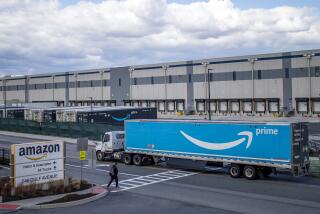The Price of Milk
- Share via
If the pricing of corn flakes seems complicated, it’s even more perplexing when it comes to milk. The reason: It’s the only commodity for which the U.S. Secretary of Agriculture can dictate a minimum farm price.
As a result, milk prices are set by federal and state regulations that, among other things, take into account where the milk is produced. The farther the farm is from the dairy heartland of Wisconsin, the higher the price.
In brief, here’s the breakdown: You buy a gallon of whole milk for about $2.30 ($2.31 at Safeway, $2.33 at Giant). About $1.30 is for the raw product before it’s processed. Another 60 cents is for processing, including the 16 cents it costs for the bottle and label. The remaining 40 cents goes to the retailer.
Because milk is regulated, the details of how it’s priced are easier to track than for many other products. The milk-marketing administrator, for example, had set a minimum July price of $13.26 for 100 pounds of fluid milk, which works out to $1.14 a gallon.
But for instance, in Washington, another premium--about 12 cents a gallon--will be added by the Maryland & Virginia Milk Producers Assn., which collects the milk from the farm and ships it to the dairy. That money goes to the dairy farmers to help offset the currently depressed milk prices.
“Dairy prices are at about the same level as they were in 1979, and farmers are faced with 1991 bills,” says Joseph Shine, business manager of the Maryland & Virginia Milk Producers Assn. The premium “is one more means to help get the funds to pay their bills,” says Shine, who notes that the idea originated with the Pennsylvania Milk Marketing Board (another price-regulating entity) and was copied by the local producers’ co-operative to remain competitive with other mid-Atlantic farmers.
Add the cost of transportation and service charges, and Giant and Safeway end up paying about $1.30 a gallon for raw milk. Unlike many other supermarkets around the country, both Safeway and Giant own their own dairies. That helps keep costs down, partly because two middlemen--the processor and wholesaler--are eliminated.
Even so, the price of milk climbs by about another dollar before it reaches store shelves. Although both supermarkets have declined to break down where that $1 goes, agricultural economists who have studied the milk industry say that about 60% of that dollar goes to processing.
The raw milk is first inspected and then tested in the laboratory for bacteria, taste and butterfat content. Then the milk is pasteurized, homogenized and clarified and finally placed in plastic jugs. Next, the bottles are held in cold storage awaiting refrigerated trucks that deliver them to the stores.
The remaining 40 cents go to cover the retailer’s cost (store fixtures, utilities, taxes, labor, etc.). Given the $2.30 price of milk, that 40 cents is a relatively small gross margin--17%, notes Richard Aplin, professor of agricultural economics at Cornell University.
More to Read
Inside the business of entertainment
The Wide Shot brings you news, analysis and insights on everything from streaming wars to production — and what it all means for the future.
You may occasionally receive promotional content from the Los Angeles Times.










